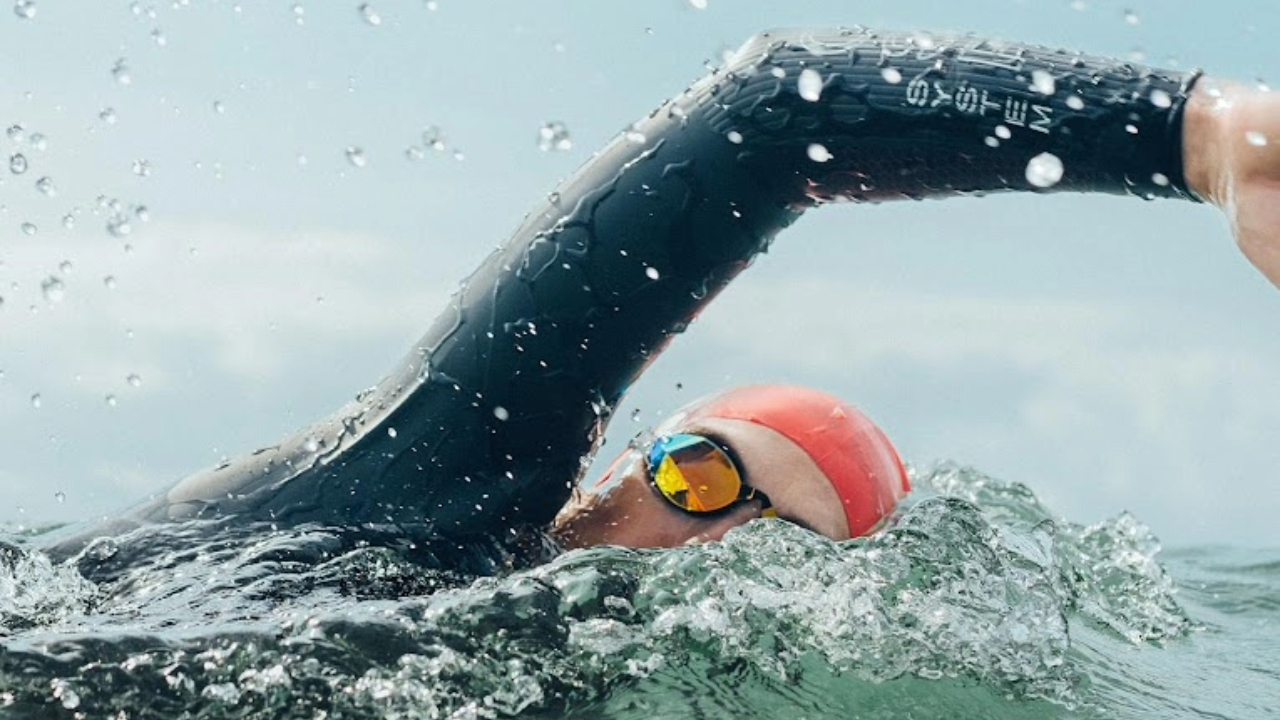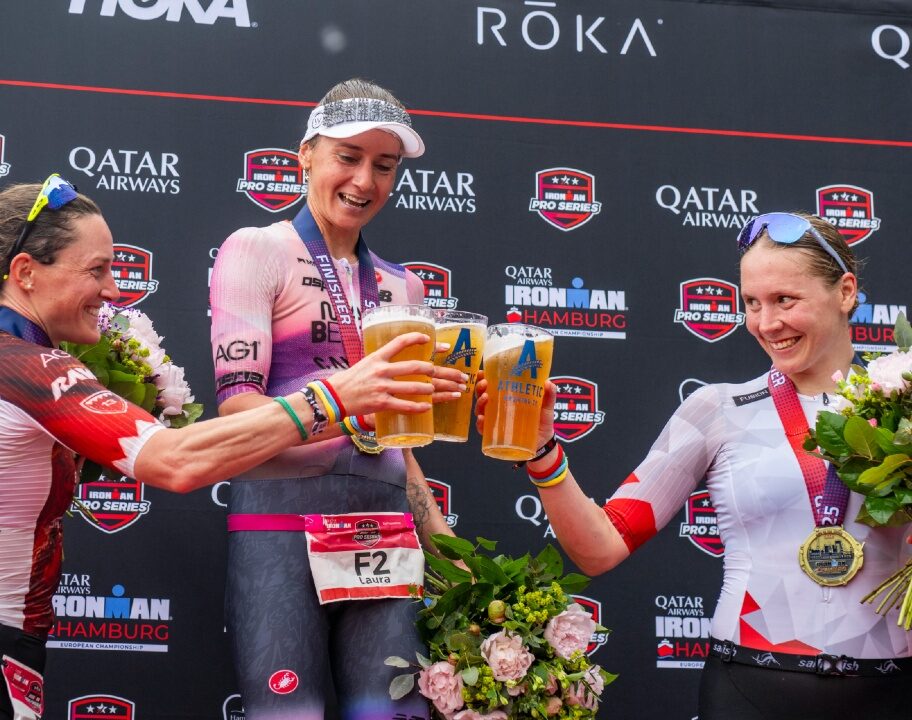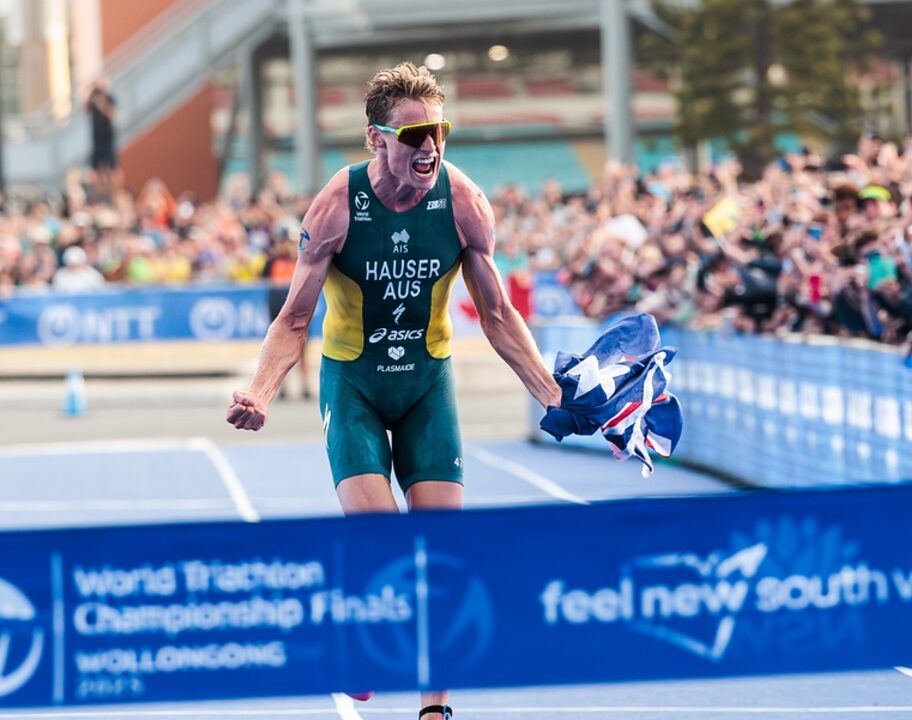Finding the right wetsuit can feel a bit like swimming against the tide. There’s so many options out there, and making the wrong choice can really spoil your enjoyment of open water swimming. Or even slow you down during a triathlon.
Whether you’re a new triathlete on the hunt for your first wetsuit. A seasoned middle-of-the-packer looking for an upgrade that will improve your swim split. Or someone who enjoys spending time in open water trying to decide which type of wetsuit is going to be the best for you. Our wetsuit buying guide is here to point you in the right direction.
- Choosing the right type of wetsuit: full cut, sleeveless, Swimrun and breaststroke
- Neoprene thickness and buoyancy: how to find the right wetsuit for your swimming style
- Premium wetsuits: is it worth upgrading to a higher spec option?
- Sustainability
- Wetsuits for cold water swimming: thermal wetsuits
- Open water swimming accessories
Choosing the right type of wetsuit: full cut, sleeveless, Swimrun and breaststroke
Before we dive into specifics around neoprene thickness and buoyancy profiles, first you need to find out what type of wetsuit you need. That depends on a few factors including the activity you want to use it for, your preferred swim stroke and the water temperatures you’re likely to be swimming in.
Full cut swimming / triathlon wetsuits
A ‘full cut’ wetsuit is the traditional style of wetsuit you’ll see most open water swimmers and triathletes wearing. A full cut wetsuit offers full arm and leg coverage, giving you maximum warmth and buoyancy in open water.

For most people, a full cut swimming-specific wetsuit is the ideal choice for taking part in triathlons or swimming in open water as it will be suitable for a range of water temperatures.
Sleeved vs sleeveless wetsuits
That being said, if you find that a full cut wetsuit feels too restrictive around your shoulders and upper body – you could consider the sleeveless option. This style of wetsuit still features full length legs for buoyancy. But the lack of sleeves gives you more range of movement through the shoulders. It’s worth noting though, that you’ll also get less warmth from this style of wetsuit. And at some triathlon races you won’t be able to wear a sleeveless wetsuit if the water is below a certain temperature.
Swimrun wetsuits
Swimrun is a sport which is growing in popularity. Part multisport, part adventure you’ll take on a course with multiple swimming and running stages without changing out of your wetsuit in between.

A Swimrun wetsuit typically features a short-cut design, a front zip instead of a back zip, and built-in pockets. It’s designed to offer a degree of warmth and buoyancy in the water. But with enough flexibility – and breathability – that you can still run in it.
Breaststroke wetsuits
There’s no hard and fast rule that you have to swim front crawl in a triathlon. But a triathlon / swimming wetsuit will usually be designed with front crawl in mind. That means the construction of the suit won’t offer the flexibility around the hips and the shoulders needed for the lateral movement of swimming breaststroke. This will create extra resistance and make swimming feel like much harder work.
If you prefer to swim breaststroke and you don’t plan to switch to front crawl anytime soon. You might want to get a breaststroke-specific wetsuit to help you feel more comfortable and less fatigued while you’re swimming.
Neoprene thickness and buoyancy: how to find the right wetsuit for your swimming style
When you start shopping for a wetsuit, you’ll notice there are different levels of neoprene thickness and buoyancy profiles on offer. What you need will depend on your swimming style. Do you tend to suffer from sinking legs, or do you naturally have a level horizontal body position in the water? Do you rely on your kick to propel you through the water, or do you have a strong upper body pull? Take a little bit of time to find out what type of swimmer you are, and you’ll know what to look for in a wetsuit to help you maximise your swimming efforts.
Beginners and sinky leg swimmers
If you’re new to open water swimming, then you might want to consider a wetsuit with thicker neoprene – typically 5mm. This will help to keep you warmer in the water, as you get used to the cooler temperatures of swimming outdoors vs in the pool. It’ll also help you to float better, as the thicker the neoprene is, the more buoyancy the wetsuit offers.
Swimmers and triathletes who notice a significant increase in speed when using a pull buoy in the swimming pool are likely to be ‘sinky leg swimmers’. This means your legs drop down in the water as you swim, rather than staying horizontal with your hips and torso. This creates extra drag, which slows you down. And it’s something that can be exacerbated in open water because you’re having to lift your head to sight, which naturally makes the legs sink lower into the water.
If you struggle with sinking legs, then you’ll want to look for a wetsuit which offers maximum buoyancy on the legs. This will help to improve your body position and help you to swim faster for the same effort.
Strong swimmers with solid technique
Thicker neoprene offers more buoyancy – but it comes at the cost of flexibility. For swimmers who struggle with technique and body position, the benefits of the extra buoyancy far outweigh the drawbacks of compromising on flexibility. But for swimmers with fine-tuned technique, it’s worth searching for a wetsuit which uses thinner neoprene around the shoulders. This will help you to feel less restricted so you can catch and pull more water with each stroke.
“When choosing a wetsuit, it’s important that the buoyancy of the wetsuit matches your technique. If you’re an experienced swimmer with a good, high body position in the water then swimming in an over buoyant wetsuit can cause discomfort – and even injury – in the lower back. Entry-level wetsuits tend to be made from thicker, ultra-buoyant neoprene so it’s worth looking for a wetsuit which offers the correct level of buoyancy for your swim style.”
Angus Greenwood, CEO and Founder Yonda Wetsuits
If you find that you usually have a good body position in the water, you might also want to consider a neutral buoyancy wetsuit. These are wetsuits which typically have 3mm neoprene all over (sometimes complemented with even thinner sections around the shoulders). This will give you the most natural feel while swimming in open water.
Premium wetsuits: is it worth upgrading to a higher spec option?
An entry-level wetsuit will see you safely through plenty of triathlon race seasons. But once you’ve got a few races under your belt, you might be starting to wonder how you can improve your swim split. While addressing any gaps in your swim training is the obvious place to start, your choice of wetsuit could also make a difference when it comes to improving your triathlon race times.
Improved flexibility and feel for the water
One of the key benefits of upgrading to a more premium wetsuit is the tech these wetsuits incorporate. You’ll notice that the higher end wetsuits are able to utilise a wider range of materials to give you the optimal balance of buoyancy where you need it, and flexibility where it’ll benefit you the most. This means that you’ll have a better body position in the water, and you’ll be able to maintain better form to swim faster and more efficiently.

Some of the top end suits also have features such as sensory ‘catch panels’ on the forearms to help you get a better ‘feel’ for the water. This will help you to pull more water with each stroke, helping you to travel further forwards with each turn of your arms.
Faster transitions
Another benefit of upgrading your wetsuit that shouldn’t be overlooked is the ability to get it off quicker in transition. The top end suits will come loaded with features such as quick release calf and wrist fabrics that are specifically designed to make sure they don’t bunch up and get stuck when you’re wrestling your limbs out of your wetsuit. You’ll also find that plenty of the premium wetsuits have a ‘slippy’ lining which again makes it easier to take the wetsuit off. It’s surprisingly easy to lose a significant amount of time trying to get your wetsuit off in transition. Upgrade to an easy-off wetsuit and you could easily shave time off your personal best without making any other fitness improvements.
Sustainability
The other thing to consider when purchasing a wetsuit is sustainability. The production of traditional neoprene using petrochemicals creates an energy-intensive manufacturing process and renders the neoprene non-biodegradable at the end of its use cycle.
A lot of wetsuit brands are now making use of Yamamoto neoprene, which is an eco-friendlier alternative. Yamamoto is made using high grade limestone, a natural raw material. This makes the manufacturing process less energy intensive. The absence of petroleum-derived oils also makes Yamamoto less likely to cause skin irritation. Plus it’s considered to perform far better in terms of warmth, flexibility and water absorption compared to traditional neoprene.

If you’re shopping for a wetsuit with sustainability in mind, look for brands who are using eco-friendly materials – both for their products, and for their packaging. You can also help to extend the lifecycle of the neoprene in your old wetsuit by participating in a wetsuit recycling scheme such as Rip Curl’s program with Terracycle, or Alpkit’s Circular Flow scheme. The neoprene can then be re-used for new products such as yoga mats and bags.
Yulex®: an emerging material in wetsuit manufacturing
The water sports scene is increasingly adopting Yulex®, a new, rubber-free alternative to neoprene. This plant-based material is biodegradable and certified as 100% deforestation-free, making it far better for the environment than neoprene. While it’s predominantly surf brands who have adopted Yulex® for their wetsuits so far, triathlon and swimming brands are also starting to step up. Zone 3 have introduced a line of Yulex cold water swim wear, and Yonda are aiming to add Yulex® to their range within the next year.
Wetsuits for cold water swimming: thermal wetsuits
Whether you’re training for an early season race and having to get into open water a little earlier in the year than usual. Or you’re looking to extend your open water season beyond the summer months. If you’re likely to be regularly swimming in temperatures below 13 degrees, it’s worth looking at getting a thermal wetsuit to help you keep warmer during cold water swims.
A good cold water wetsuit will usually have some form of thermal lining to bolster the warmth you get from the neoprene. Look out for thermal wetsuits which also have higher necklines – the neck can be particularly sensitive to the cold so this will help to make cold water swims feel that bit more comfortable. Bear in mind that a lot of thermal wetsuits will utilise thicker neoprene than their summer counterparts, which can make them trickier to get in and out of if you’re planning to use yours in a race. But brands such as Zone 3 have integrated features such as ‘easy-off’ leg and arm cuffs to make it easier to whip your wetsuit off – whether you’re rushing through transition, or just rushing towards a hot shower.
If adding another wetsuit to your collection isn’t an option, you can also ramp up the warmth of your summer wetsuit by layering it with a neoprene swimsuit/rash guard and using a thermal cap and neoprene swimming gloves.
Related: Cold water swimming gear guide
Open water swimming accessories
Alongside a wetsuit, there are a few other essentials you might want to consider adding to your swimming kit bag. The first is a brightly coloured swim cap, to help keep you visible in open water. A tow float – a small inflatable which you tether to yourself – is also a good option to help keep you visible. If you’ve only ever swum in the pool, then you might want to consider your choice of goggles. Clear goggles are perfectly fine in overcast conditions. But if you’re swimming in open water when the sun is shining, you might also want to get a smoke-tinted pair to protect your eyes against the sun’s glare.
A changing robe or a Dryrobe isn’t an essential, but it’s something you’ll definitely appreciate before and after your open water swims. We’ve gone into more detail on cold water swimming accessories in our guide to essential cold water gear. But as a starting point, a neoprene hood or headband can really help to reduce the cold water ‘brain freeze’ so you can feel more comfortable during your chilly swims.
Set yourself up with the right gear for the style of swimming and the conditions you’ll be experiencing, and you’ll get the most enjoyment – and training benefit – out of your open water swimming.











